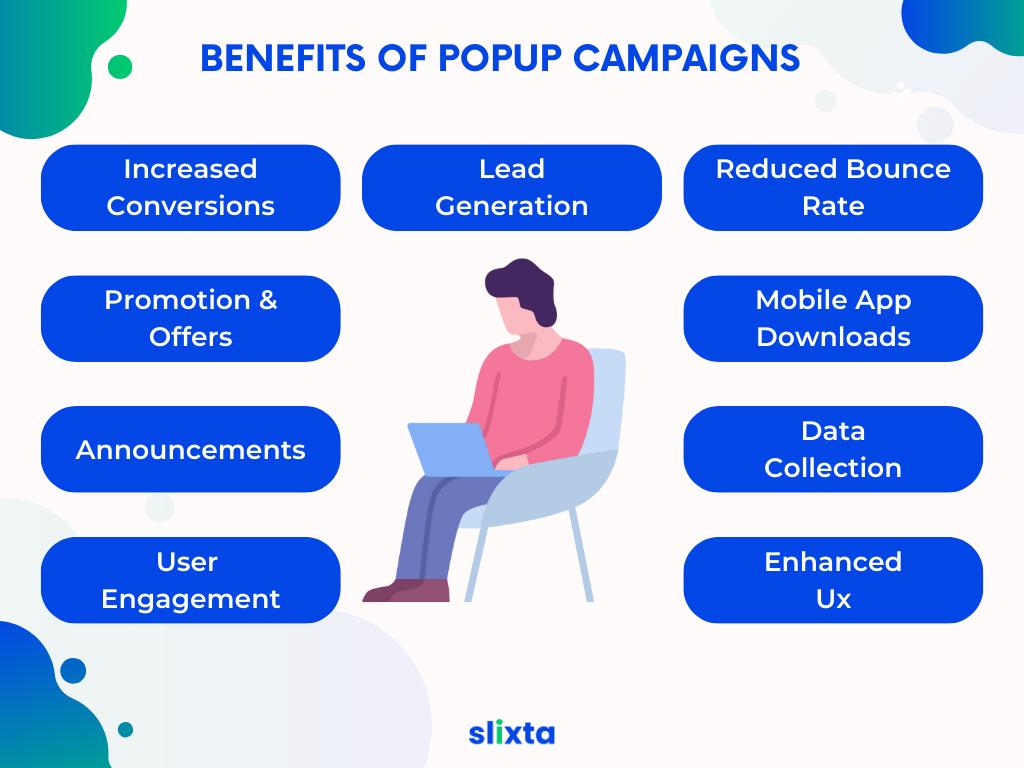Popup campaigns, brief displays on a website, can significantly benefit by capturing user attention and prompting actions like email subscriptions or promoting special offers. When implemented strategically, these campaigns enhance engagement and user experience. However, it's crucial to find a balance to avoid user irritation and optimize the effectiveness of popup campaigns.
Popup campaigns are strategic marketing techniques employing small windows, known as popups, to convey targeted messages or offers to online visitors. These pop-ups can emerge on websites accessed through desktops, mobile devices, and even within mobile apps. Their significance in digital marketing lies in their capacity to seize attention, involve users and prompt specific actions. Popups are potent tools for enhancing conversions and user engagement. Yet, their impact hinges on meticulous design and implementation, ensuring they do not disrupt users' experience. Let's delve into the realm of popups and discover their potential.
What are Popups?
Popups are graphical user interface (GUI) elements that appear suddenly on top of the content of a website or web application. They are typically displayed in a separate window or a dialog box, overlaying the existing web page or application interface. Popups are often used to draw the attention of the user to a specific message, offer, or call to action. They can contain various types of content, such as text, images, forms, or buttons, and are commonly utilized for different purposes in web design and online marketing.
Popups on mobile devices function similarly to those on desktop websites but require special attention due to the smaller screen size and touch-based interactions. Mobile popups, when used thoughtfully, can enhance user experience and engagement. However, they need to be implemented carefully to avoid frustrating users, as mobile users tend to have less patience for intrusive or poorly designed popups.
Benefits of Popup Campaigns for Businesses and Marketers

Increased Conversions
Well-designed popups can guide visitors to take specific actions, such as making a purchase, subscribing to a newsletter, or downloading an app. This targeted approach often leads to higher conversion rates.
Lead Generation
Popups can capture visitor information, such as email addresses, enabling businesses to build a valuable database of leads for future marketing campaigns.
Reduced Bounce Rates
Exit-intent popups can effectively reduce bounce rates by presenting compelling offers or content when visitors attempt to leave the website, encouraging them to stay longer and explore further.
Promotion of Special Offers
Popups are great for promoting limited-time discounts, sales, or exclusive deals. They create a sense of urgency, encouraging users to make immediate purchases.
User Engagement
Interactive popups, such as surveys or quizzes, engage users actively, providing insights into customer preferences, which can be invaluable for tailoring products or services.
Enhanced User Experience
When used thoughtfully, popups can enhance user experience by providing relevant content or offers based on user behavior and preferences.
Mobile App Downloads
Popups on websites can promote mobile apps, driving installations and increasing a brand's mobile presence.
Data Collection
Popups can collect valuable data about user behavior, preferences, and demographics, enabling businesses to make informed marketing decisions.
Personalization
Popups can be personalized based on user segments, showing tailored offers or messages to different audience groups, increasing relevance and engagement.
Announcements and Updates
Popups can be used to announce new products, services, or features, ensuring that important information reaches users directly.
Feedback and Surveys
Popups can facilitate feedback collection, allowing businesses to gather customer opinions, and improve products or services based on user suggestions.
Best Practices

Timing is Crucial
Popups should be displayed at the right moment. Consider using exit-intent popups or displaying them after visitors have spent some time on the site. Avoid showing popups immediately after a visitor lands on the page.
Mobile Responsiveness
Ensure popups are mobile-friendly and responsive. Test their appearance and functionality on various devices and screen sizes to guarantee a seamless experience for mobile users.
Easy to Close
Include a clearly visible and easy-to-click close button. Users should be able to dismiss the popup effortlessly if they choose not to engage with it.
Minimalistic Design
Keep the design clean and minimal. Too much content or flashy graphics can overwhelm visitors. Use concise and compelling copy, accompanied by relevant visuals.
Relevancy is Key
Tailor popups to specific pages or user segments. Personalize the content based on user behavior, interests, or demographics. Relevant offers or messages are more likely to engage users.
Value Proposition
Clearly communicate the value users will receive if they engage with the popup. Whether it's a discount, exclusive content, or useful information, the benefit should be evident.
Compliance and Transparency
Ensure your popups comply with legal regulations, such as GDPR for user data collection. Be transparent about how user data will be used if you're collecting information through popups.
Loading Speed
Optimize the loading speed of your popups. Slow-loading popups can frustrate users and negatively impact the user experience.
User Segmentation
Segment your audience based on behavior and preferences. Show different popups to different segments, ensuring a personalized experience for each user group.
Understanding Popup Campaigns: Beyond the Surface
Popup campaigns, often overlooked or dismissed as intrusive, are actually sophisticated tools designed to deliver targeted messages to website visitors. Contrary to common misconceptions, popup campaigns aren't just annoying pop-ups that disrupt the user experience. When implemented thoughtfully, they can be a valuable asset for businesses looking to increase conversions, gather user data, and enhance overall engagement.
Crafting Engaging User Experiences
One of the primary benefits of popup campaigns lies in their ability to craft personalized and engaging user experiences. By strategically presenting relevant information or offers based on user behavior, preferences, or demographics, popup campaigns can capture the visitor's attention and prompt them to take desired actions. Whether it's showcasing a limited-time promotion, announcing a new product, or encouraging newsletter sign-ups, well-designed popups can make the difference between a visitor bouncing away and a potential customer staying engaged.
Building and Expanding Email Lists
Email marketing remains a potent tool for businesses to connect with their audience. Popup campaigns provide an effective means to grow your email list by encouraging visitors to subscribe in exchange for exclusive content, discounts, or updates. The key here is to strike a balance between presenting a compelling offer and respecting the user's browsing experience. When done right, popup campaigns can significantly boost your email subscriber base, providing a direct channel to nurture leads and foster ongoing engagement.
Reducing Cart Abandonment in eCommerce
For eCommerce websites, combating cart abandonment is a perpetual challenge. Popup campaigns can be strategically employed during the checkout process to address hesitations, offer discounts, or provide additional information that encourages the user to complete their purchase. By understanding the user journey and deploying targeted popups, businesses can recover potentially lost revenue and improve their conversion rates.
Navigating the Pitfalls: Best Practices for Popup Campaigns
While the potential benefits of popup campaigns are evident, it's crucial to approach their implementation with finesse. Poorly executed popups can indeed be disruptive and drive users away. To harness the power of popup campaigns effectively, consider the following best practices:
Timing is Everything
The timing of a popup is critical. Interrupting a user's experience with a popup immediately upon landing on a website can be counterproductive. Instead, opt for triggers based on user behavior, such as time spent on the site, scrolling depth, or exit intent. This ensures that popups are presented at opportune moments, increasing the likelihood of engagement.
Clear and Compelling Copy
The language used in popup messages plays a pivotal role in their effectiveness. Keep the copy clear, concise, and compelling. Clearly communicate the value proposition or offer, making it easy for users to understand the benefits of taking the desired action. A well-crafted message can transform a popup from an annoyance into a valuable interaction.
Mobile Responsiveness
With the ever-increasing use of smartphones, ensuring that popup campaigns are mobile-responsive is non-negotiable. Mobile users should have a seamless experience, with popups that are appropriately sized, easy to close, and do not obscure crucial content. Failing to prioritize mobile responsiveness can alienate a significant portion of your audience.
Popup Campaigns in Action
Increasing eCommerce Conversions
An eCommerce site facing high cart abandonment rates implemented an exit-intent popup offering a limited-time discount to users on the verge of leaving the site. The popup, triggered when users moved their cursor towards the browser's close button, resulted in a significant reduction in cart abandonment and a notable increase in completed purchases.
Growing Email Subscribers for a Blog
A popular blog seeking to expand its email subscriber base used popup campaigns to offer a free downloadable resource in exchange for newsletter sign-ups. By strategically placing the popup on blog pages with high traffic, the website experienced a substantial increase in new email subscribers, enabling them to nurture a larger audience through regular content updates.
Conclusion
Popup campaigns have emerged as indispensable tools in the digital marketer's arsenal, offering a versatile and engaging way to connect with online audiences. By strategically implementing popups on websites and mobile apps, businesses can harness their power to significantly impact user behavior and drive conversions.
Businesses and marketers are encouraged to embrace these innovative techniques, leveraging their potential to create impactful, personalized, and engaging online experiences for their audience. With strategic popup campaigns, businesses can forge meaningful connections, inspire user loyalty, and ultimately drive their digital success to new heights.
For more valuable insights and information, check out these recommended blogs:

